#meurian animal
Explore tagged Tumblr posts
Text
[LORE CORRECTION: It Oscar I who was Celia's husband. At the time this was written, Prince Oscar II was meant to be the 4th Oscar in his bloodline.]

“Or… you could kill him.”
There was a moment of breathless quiet as the two women stood under the grape-twisted arches of the palace gardens. The only sound that dared itself to be heard was the rustle of leaves in the gentle summer breeze, and the quiet snuffle of the clueless baku cub that trotted beside them. What Ancha suggested was not only murder, but regicide.
It was Queen Celia broke the silence. She brought her hand to her face and tittered, her manner as delicate and ladylike as she ever was in court. “Oh, Ancha, stop!”
Ancha’s face softened. “I’m just putting it on the table, love.” she teased, peering back over the edge of her habit.
Keep reading
74 notes
·
View notes
Text
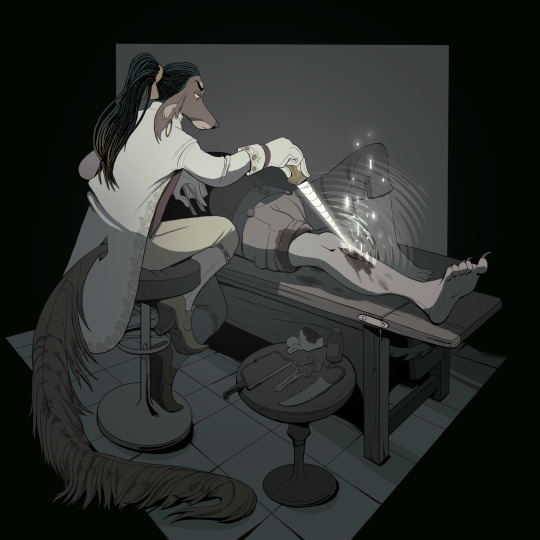
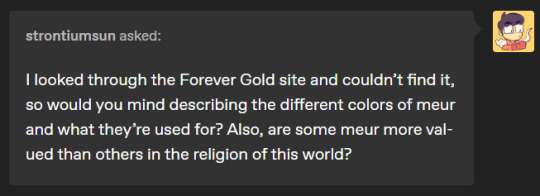
(Sure thing! I answered this in two parts - I went over meur types here, so I'll talk about what's considered highly valued in this post.)
Oscar sees to an unfortunate soul presenting with shrapnel in the right leg. After removing the offending pieces, white meur can be used to expedite bone regrowth and to close the wound. This greatly lowers the chance of infection. In many instances, white meur is the difference between a minor procedure and a painful death by sepsis.
In Cerostianism, all meur (besides black) is considered a gift from the Architect bestowed upon a lucky chosen few. Though it’s now understood by the common man that the ability to wield meur is passed by blood and probably not divine ordinance, the use of meur is still considered holy.
While all meur is a gift, the most sacred symbol in Cerostianism, the narwhal, is a blue meurian animal. Blue meur features heavily in religious texts and symbolism. I’ll honestly have to talk another time about the significance of blue meur in religious life. It’s much easier to talk about how white meur is also cherished: both in religion and wider culture.
The process of becoming a white practitioner is difficult. Moreover, white meur relics (with which to use white meur) are equally scarce. After the invention of the Andimeur synthesizer, demand for the white meurian animals exploded, and they were hunted to extinction. White meurian animals don’t preserve well either, so no further specimens have ever been found. All white meur relics in use are about as old as the Tri-Kingdom itself.
Everyone needs healing and medical attention though... and so white practitioners must by necessity be very busy and selfless people. Many of the newer Saints in Cerostianism were white practitioners in life. It isn't uncommon for white practitioners to die young, adding to the mystique. It’s said that the sick make better practitioners because the Architect blesses them with the saintly ability to understand the suffering of their fellow man... though anyone with sense will point out that it’s more likely because of the nonstop travel, back-breaking schedule and frequent exposure to disease.
The Andimeurs – that is, the midland royal family, have historically been white practitioners. Prince Oscar is no exception to this. His dedication to his patients (and subjects) is proven daily. All know of the countless hours he spends tending to the sick at his open clinic within Diadem’s Mane Quarter.
#furry art#magic system#fantasy world#white magic#mild blood /#medical //#even though its magical medicine. just in case#FG world info#world: forever gold#oc: oscar#my dog has a magic medical license....
45 notes
·
View notes
Text
Tag Index
Development Updates
Nothing to see here yet.
Interactions
#ask - Answered asks submitted by followers.
#character ask - Answered asks pertaining to characters.
Art
#art - All posted art.
#dan art - Art drawn by Dan.
#ls art - Art drawn by LS.
#collab art - Collaborative art both Dan & LS worked on.
#human mode - Art of characters using their human designs.
#snout mode - Art of characters using their anthro designs.
Characters
#c: quincy ❖ #c: d'angelo ❖ #c: lucas ❖ #c: oscar ❖ #c: kaitos
#c: ancha ❖
Worldbuilding
#worldbuilding - General worldbuilding infoposting.
#meur - Posts about meur.
#meurian animal - Posts about meurian animals
#hare - Posts pertaining to hares specifically.
#animal - Posts about mundane animals.
0 notes
Text

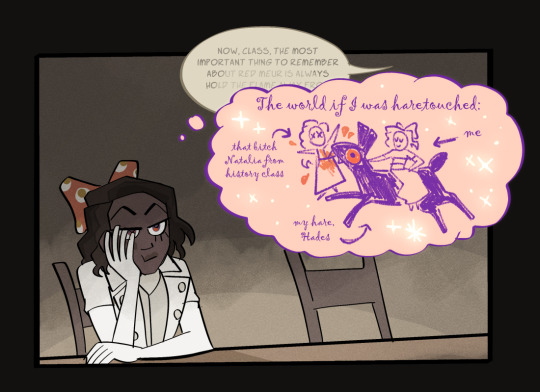

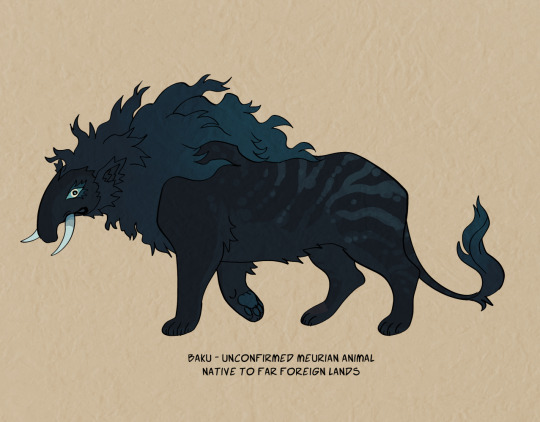

Hares, as you may already know if you've been following my better half @broncoburro or @forevergoldgame (if you're following neither, you're missing huge amounts of context for the setting!), are nothing like the hares of the real world. They are massive leporids from Northern Vestur and one of the few meurian animals remaining after a historic event known as the Great Hunt where humans wiped out most of the planet's remaining meurian species in order to harvest their meur for relics about 350~ish years ago. They are obligate carnivores and known to hunt humans when the opportunity arises.
The baku is a large, lumbering omnivore with a similar ecological niche somewhere between a panda and a regular bear. They're a rare species, endemic to a single far-flung region of the world, having only just barely escaped extinction. See, while the Great Hunt was headed and funded by the Tri-Kingdom, its reach spanned the entire known world - but the further from Vestur it travelled, the less discriminatory the hunts became. The local peoples who were paid to hunt on the Tri-Kingdom's behalf had little idea of what meur was and what meurian animals were actually useful, leading to mass to mass culling of "useless" meur-touched animals like the baku, whose unusual sleep-inducing abilities cannot be wielded by humans. Regardless of their uselessness, the damage had been done to the species, and only the mundane offshoot survives - though rumors persist about meurian baku.
Sphinxes are scavengers that can be found across the deserts and savannas of the mainland. Unlike their meurian cousin, the manticore, they never evolved meurian flame breath, and their 'stinger' is no more than a vestigial sickle buried beneath the fur of their flowing tails. Instead, they specialized further into human mimicry, using their ability to copy human speech to hunt domesticated animals, naive children, and drunkards.
Now you might be thinking: "why would a teenage girl want to own any of these as pets? None of these sound like animals that should be pets." Well, first off: you'd be hard pressed to find a young girl that doesn't want a wolf or a tiger as a pet, that's just how they are, c'mon.
Second, there are three primary reasons Rhea thinks this is a more realistic idea than it is:
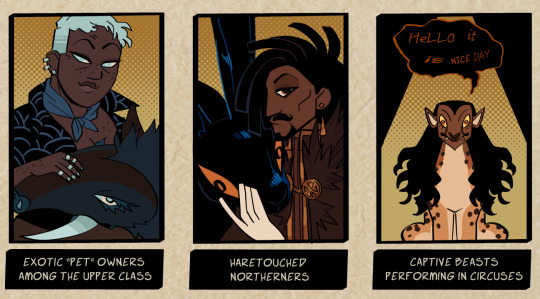
Exotic "pet" owners among the upper class: While exotic pet ownership isn't big in Vestur as a whole, it has a notable presence among the Southern upper class, both noble and common. Rhea is the duchess of the Southern Kingdom so she is well aware of every instance of somebody paying excessive amounts of guilder to import something they shouldn't and stick it in their courtyard. As I've mentioned before, this is a sin Ancha is guilty of, having gotten swept up in a past "teacup baku" craze/scam some 4 decades ago. Unlike her peers, however, she kept her baku, Fig, even after he outgrew his alleged "adult size" of 1'9" at the withers. Others culled theirs once they became large enough to cause mass property damage. Ancha knows Fig is a massive, terrifying wild animal and does not recommend anyone repeat her mistake, but being raised in captivity he cannot be returned to the wild and so she's committed to caring for him for as long of his estimated 70~ish year lifespan that she's here for.
Haretouched Northerners: The "haretouched" is a strange phenomenon that exists in the North. Now, we haven't posted a formal explanation of what exactly being haretouched means yet - I'll save that explanation for Dan to write at a later date. In the meantime, to very briefly summarize what it means: occasionally, a hare will bond with a specific human. Those who have bonded to a hare are said to be "haretouched" - or more bluntly, cursed. The haretouched are treated as pariahs by broader society, though they are begrudgingly tolerated in the North itself and destigmatized by Northern nomad clans. While Northern nobility has done its best to keep the haretouched out of their bloodlines (save for the Lord of the Nomads, who is seldom acknolwedged, much less counted), occasionally a fluke will occur regardless and you end up with someone like Quincy or Lamonte. Rhea, of course, is just a Southern bystander who thinks the idea of having a murder-bunny for a friend would kick ass.
Captive beasts performing in circuses: Self-explanatory. Sphinxes especially are a popular choice for exploitative entertainment because of their mimicry abilities, and are often trained to have "conversations" or "sing."
#verse: forever gold#oc: rhea#answered ask#character ask#oc askblog#fantasy setting#fantasy animal#sphinx#baku#creature design#monster lore#creature concept#oc: ancha#sc: fig#oc: lamonte#sc: tulip
74 notes
·
View notes
Photo
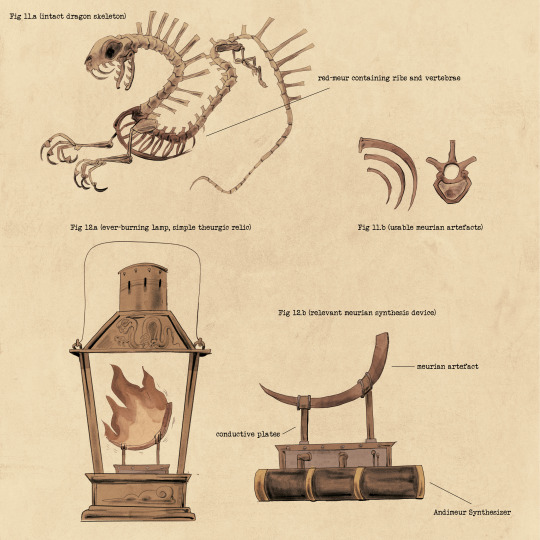


Excerpts from "HISTORY AND FORME OF THEURGIC RELICS", a 1798 textbook detailing how magic (in technical: meur) is converted into a form usable by man.
This book was published during the Second Vesturian Civil War.
PAGE 213
Take for example the dragon, a once-plentiful creature. There are many intact skeletal remains of dragons below the ice of the Endless Wasteland. Northern Miners exhume these remains and separate out the pieces capable of generating magic (from here called "meurian artefacts").
The dragon in life generated red meur in its' chest cavity, summoning fire to burn its foes. The usable meurian artefacts are the thoracic vertebrae and ribs. These are sent southward to the Middle and Southern Kingdoms for processing.
A meurian artefact can be paired with an an Andimeur Synthesizer in a process aptly called "synthesis". The meur from the artefact then may be channeled in a way usable by humans.
These completed objects are called theurgic relics. Those with noble blood have the ability to handle and utilize theurgic relics for a variety of applications.
An ever-burning lamp is a common decorative relic among the elite - they are cheap to manufacture and require only the smallest artefacts to keep a brilliant flame.
FIG 11.a: Fossil remains of a dragon. Red meur can be detected in its' ribcage, where it used meur to generate fire as a defensive tactic.
FIG 11.b: Usable pieces extracted from the skeleton: "meurian artefacts".
FIG 12.a: A simple Andimeur Synthesizer, attached to a dragon's rib bone.
FIG 12.b: Early decorative ever-burning lamp of Southern Kingdom make, circa 1632.
PAGE 302
The most potent of artefacts, such as the thoracic vertebrae of the dragon, are best used in weaponry. Theurgic relics that are weapons are versatile. A skilled wielder of meur may just as easily heat a pan with their theurgic weapon as burn a foe.
FIG 30.a: A brass knuckle fashioned out of dragon vertebrae. A small and efficient Andimeur Synthesizer resides in the grip.
FIG 30.bcd: The red meur may be synthesized in many ways: projected fire, conductive heat, or ambient heat are just some of the ways it may be channeled.
PAGE 315
The greatest and most impressive theurgic weapons are made with the rarest of meurian animals. A principal examples is the unicorn staff, owned by the Andimeur family. It uses a horn from the exceedingly rare unicorn as a conductive weapon that can synthesize any meur type. There is only one known unicorn horn in existence.
FIG 30: An eclectic combination: a commoner’s weapon, the Duruger M1875, retrofitted into a black meur theurgic weapon using hare teeth.
FIG 31: The Andimeur's unicorn staff, pictured with sheath. It can be used as a walking cane when sheathed.
FIG 32: The Andimeur's other family theurgic weapon - the manticore rapier. The tail generates devastatingly hot red meur. The Andimeurs once kept and used manticores for hunting unicorns.
FIG 33: A scythe fashioned from the jawbone of a "demon", a green meur creature remembered for its habit of pilfering human corpses. This particular theurgic relic is utilized by famous Lieutenant General D'Angelo Barghur. Green meur can be dispersed into fields to boost crop yield, as well as used in combat to manipulate the earth, or cause weaponized overgrowth.
#fantasy worldbuilding#magic system#magic weapons#worldbuilding#original setting#world: forever gold
168 notes
·
View notes
Note
The hares sound interesting, can you explain more about them? :o

Hares are a leporid-like meurian (magic) animal that inhabit the frozen wastes and mountains of the Northern Kingdom. They gather in loose-associated groups of 15-20 individuals. They have a glossy black, iridescent coat not unlike those of the raven. It is difficult for the layperson to tell any two hares apart, though the haretouched swear there is a difference between "cockatrice green" and "leviathan blue" sheens…
They are obligate carnivores - while they prefer an easy scavenged meal, non-domesticated hares are not unknown to chase down a lone human wandering the wastes for a meal. Their teeth contains black meur. A bite from a hare causes instant necrosis. They are very capricious and difficult to handle.

Life in the northern wasteland is harsh - there is little food or shelter from the driving snow. For unknown geological reasons, sometimes an area will have an explosion of meur. A small patch of waste will be transformed for a time into greenery, or a clean lake. The hares can sense meur and naturally gravitate towards these "meur fonts". Historically, the nomadic Northern clans survived by having their hares guide them to fonts, where they could warm and gather materials before the font dries up and they must navigate dozens of miles to the next.
These days, Northerners live in permanent settlements, but hares continue to be important. They are the only steeds nimble and hardy enough to navigate the area's terrain outside of towns. Their meur-sensing abilities continue to be useful in the mining of meurian artefacts, an industry that dominates the Northern economy.
…Fermented hares' milk is also a popular drink in the north, despite no other peoples being able to stomach it. It is mildly poisonous and ranges from "slightly astringent low alcoholic beverage" to "extremely potent hallucinogen".
287 notes
·
View notes